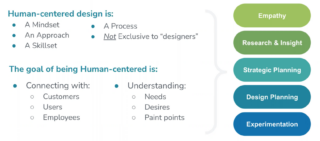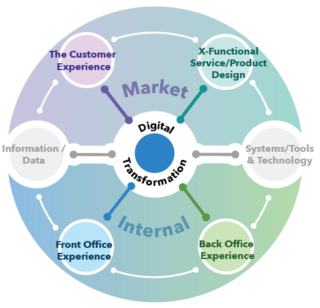Building a Human-Centered Business
Building block 1 to Design-Driven Digital Transformation by Jon Fukuda
This blog is part one of a five-part series on design-driven digital transformation. In this post, we explore the foundational building block of human-centered digital transformation—creating a culture of human-centricity as a core strategy. By focusing on customers and employees, organizations can unlock sustainable transformation and foster innovation.

Engagement on two fronts
The human-centered approach to digital transformation requires a fixed position on two fronts of your organization. The first and highest priority front is in the market with your customers and users. The second front is in aiding a culture of continuous learning and change from within the organization through human-centered practices.
“Digital transformation is a human-led, tech-enabled, customer-centric process of continuous learning.”
-Growth Tribe
What is Human-Centered Digital Transformation?
When asked to define digital transformation, we use this definition coined by Growth Tribe, “Digital transformation is a human-led, tech-enabled, customer-centric process of continuous learning.” The two fronts that unlock this capability are keeping a continuous ear to the ground in the market with your customers to ensure that you’re building and providing the right services at the right time in the right ways while building the scalable capacity to respond. And at the same time, enabling the people within your organization to continuously learn and adapt as they listen to what customers want and need.
Market Focus in Human-Centered Digital Transformation
The traditional business has a set of core services and products that generally come from a set of internal business strategies. Not to over-generalize, but deployment against new services and products is typically the result of careful planning, product requirement documents (PRDs), and lengthy definition and development phases. While it’s true that teams have become more agile in deploying a continuous integration model, there is still a gap between CX/UX research, design planning, experimentation, and the products and services deployed. This is what we refer to as the last mile in closing the loop on continuous design and continuous development.
Human-centered digital transformation bridges the gap between research and deployment. Bridging this divide requires an intentional focus on hiring researchers and designers and deploying them on your product teams. But the real inflection point for your organization in deploying desirable services and products with velocity and at scale comes from your capacity to:
- Deeply integrate practices for rapid customer and user research
- To democratize research insights
- To rapidly deploy interactive prototypes or live production tests with active users/customers
- To scale design practice with atomically designed and developed UI component libraries
The more clearly your teams can get feedback from live users and customers on your products and services, and the more rapidly you can respond either through experimentation or product/service enhancements, the more deeply connected you can become in your customers’ lives.
By strengthening your capacity to listen, learn, and respond to dynamic changes in the market, and in the minds of your customers, the more desirable and meaningful your product and service experiences will be. People want to build relationships and engage with those who make them feel heard, and where their needs are met. The most deeply set human experience of “belonging” has a massive impact on business and can unlock long-lasting relationships.
Operational Focus: Empowering Employees for Transformation
The people in your organization — from those who work with your customers, to those who design and build your products and services and help run the day-to-day operations — are the lifeblood of your business. A strong operational foundation is key to human-centered digital transformation. Just as building strong relationships with your customers will strengthen your capacity to deliver meaningful products and services, listening to and empowering your employees to drive successful outcomes. With a clear and strong human-centered focus on both fronts, you will have the capacity to throttle your business into innovation and transformative experiences.
Learning, as it turns out, is a lifelong process. Those empowered with continuous learning coupled with a safe environment to experiment – even when those experiments might fail – will possess the capacity to create ecosystems ripe for innovation and market-leading products and services.
Internally focused human-centricity can be broken down into the following areas:
- Assess the current state of tools, processes, needs, pain points, and successes. You should attack this from an inter-departmental (horizontal) perspective to trace key journeys (business processes) in the organization from start to finish. For example, follow a process from customer service, through business operations and reporting etc. to ensure you’ve understood all the opportunities to enhance the employee experience for better and more valuable business delivery.
- Open opportunities for cross-functional collaboration, and bring subject matter experts from across the organization together to research, conceive, define, design, and test new models of services or products and features. Bind the various disciplines in the organization in a spirit of innovation, curiosity, and passion for improved products and services.
- Create a culture of continuous learning and improvement through robust career development, incentives for research, development, and cross-functional collaboration.
- Finally, make it a safe space to experiment and learn, even if this means risking failure. By taking small, incremental risks with mitigating rollback protocols, the team can learn what works best for the customers and the teams that support their experiences.
Bridging the Gap: Two Fronts of Human-Centered Digital Transformation
Embracing human-centered digital transformation requires cultural shifts across the organization. Making this shift depends on a top to bottom adjustment to how the human experience is valued both respective to and from within your organization. This shift is complete when you have not only implemented continuous research and design cycles at the market front, but when your internal operations have embraced models, measures, and processes that value the employee experience as highly as the customer experience. To achieve this, ask your design leaders to bring the rest of the organization along in building the capacity to sense and respond both in the market and across the organization. Build Journey maps that outline the customer experience, and the operations behind the experience. Build service design blueprints that look at both front and back office operations to identify opportunities for enhanced service delivery and celebrate your collective success as you drive innovative new solutions that support not only the customer experience but your entire organization’s experience as well!

Summing it up
Setting human-centricity as a cornerstone of your digital transformation initiative will unlock the first gate to sustainable transformation. Stay posted for the next four posts elaborating on tactics and strategies for design-driven digital transformation based on our free webinar.